Classic Pistol Report
The Colt Officer’s ACP Rocks On…
By Brian Jensen
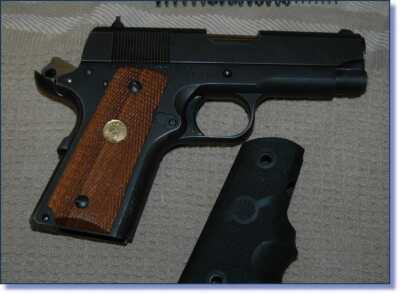 |
| Colt Officer’s ACP – not bad for a twenty-plus year old. |
Years ago I purchased a used gun in a box of old gun bits and pieces from an estate sale. It was one of those, “right place, right time” moments when the seller and the gun store didn’t want to bother with sorting out what was there – some assorted 1911 bits and pieces – and none of which seemed to work. The gun-store owner saw me coming in and since he knew I liked 1911’s, he told the seller I might be interested. I offered a few bucks for what looked like a bunch of parts and a frame, and did my paperwork.
After combing through the assorted stuff in the box I found that I was able to put together all the parts to a 1911, and under it all was a slide marked “Colt MK IV” on one side, and “Officer’s ACP” on the other side beneath the ejection port. Soon I realized in amongst the junk were all the parts to the Colt.
The first time I saw an Officer’s ACP, it was in the movie Heat with Al Pacino. While this is still one of the all-time great movies for shoot-outs, I just thought that gun in particular that Pacino’s character carried was the essence of “cool”. Now while the 1911 Government has made all kinds of movie appearances, the Officer’s models gets far less attention, and I am not surprised when some don’t recognize it, or know it for what it is.
A Little History
The Officer’s ACP was introduced in the mid 1980’s to compete in the growing concealed carry market. The full size 1911 with its 5-inch barrel was often too big for concealed carry. The Commander Model with a full-size grip and a 4 ¼ inch barrel came along in the 1950’s, but some considered it still too big.
Then, around 1985, Colt introduced an all-steel copy of the original Colt government with a 3 ½ inch barrel – ¾ of an inch shorter than a commander, and 1 ½ inches shorter than a full-size government model. Colt also worked to shorten the length of the grip to aid in concealment, dropping the capacity to six rather than the usual seven rounds of 45 ACP. (With modern magazines 7 rounds is now the standard.) At the time it was introduced, it was one of the smallest weapons of that caliber.
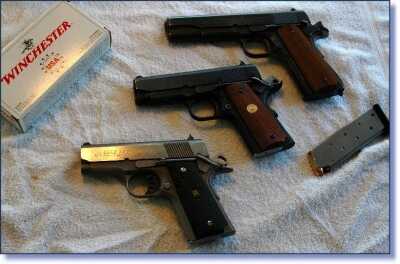 |
| The Colt Officer’s ACP (Center) between a WWII 1911A1 (Top), and a newer Colt Defender (Bottom). |
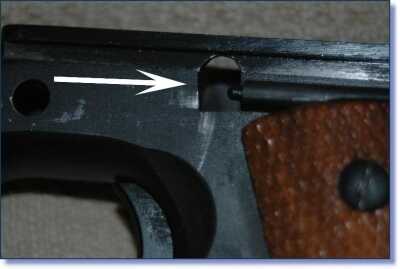 |
| Older Colts still maintained the open, or oval-type, window for the slide-release lever. |
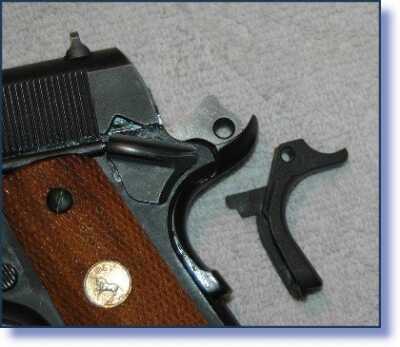 |
| The original Colt grip safety next to a newly installed Wilson Combat beavertail safety. The original Colt piece is more compact, but the author prefers the Wilson model for feel. |
This gun was prized for its compactness and robust power in the venerable 45 ACP. Many consider the 1911, even the small ones, the epitome of a great defensive pistol. I once spoke to a trauma surgeon who had one of the rare CCW’s issued in my county in Southern California. He also had served in the military, and he carried a Colt Officer’s model for the very reason that based upon his experience and from what he’d learned from his peers in the service about the 45 round. If there were someone I would trust in the area of wound ballistics, it would be someone like a trauma surgeon.
Over time, Colt introduced an aluminum frame, subcompact 1911, called the series ’90 Lightweight Defender. It had a 3-inch bull barrel, as well as a different spring setup. This model soon replaced the Officer’s ACP, which was discontinued in the 1990’s. However, there are enough out there that they are fairly easy to find. They are also a piece of Colt history, that some collect just for the nostalgia of it.
My Model
My Officer’s ACP was an early matte-blue steel model. The first clue that it was an early model was that the weapon still had the oval shaped opening in the frame where the slide stop lever moves up and catches the notch in the slide. You will see this often in older 1911 models. It was later found that this was an area that tended to crack over time, and it was later changed to an open notch on the frame as you see now in many modern 1911’s. Mine was still in relatively excellent shape with nothing more than some surface scratches and some “idiot marks” from people putting the weapon back together.
In fact, a check with Colt revealed the serial number was from the first year they made the model, in 1985.
The Officer’s ACP does have a heavy-almost bull barrel design, but still uses a barrel bushing. This is unlike the bull barrel seen on models such as the Colt Defender or Kimber’s Ultra, which completely fills the inside channel of the slide. My Officer’s model also had the original Colt double spring assembly. This unit was like a small standard recoil spring lug, but with two independent springs, one inside of the other.
What I immediately liked was the slightly longer barrel than my Defender, and while it was only ½ inch longer than the three-inch model, I usually want as much barrel as I can get to keep bullet velocity up. Shorter barrels will mean you loose bullet speed, and a slower bullet will loose kinetic energy. But more importantly, it may not get enough speed to reliably expand as much as needed once it hits its target. This has long been a complaint about most shorter pistols in general. It also doesn’t hurt to have more sight radius for better accuracy when you’re just plinking away at the range.
Speaking of sights, this model came with the standard for Colts at the time. Before we had Novak or low mount sights, there was just a three dot system with a steel post and straight notched piece of steel to the rear. Not sexy or fancy, just plain functional.
The Officer’s Model also uses a steel frame rather than the aluminum or alloy frames used by the Colt Defender or other subcompact 1911’s. (Colt later developed a limited number of aluminum framed “Lightweight” Officer models as well.) In shooting, this definitely helped with recoil, but not as much as I had expected. My Defender has a semi-captured dual recoil spring assembly that dampens recoil just as much. Regardless, there is just something nostalgic about a steel-framed Colt…it just feels more, well like a “real” gun.
The finish on my Officer’s was a matte blue that reminded me of a high quality Parkerizing job, but there were bright blue and stainless models made throughout the different models of this weapon when it was produced. This one’s finish has minor blue wear in all the usual areas: along the edges of the grip, at the muzzle, and on the edges that rode against the body. However, it’s all surface wear. Overall, if you look at the rails and the barrel, it’s pretty clear this weapon did not get a lot of rounds downrange.
The Colt Officer’s had a commander hammer and a grip safety that protected the hand with as little metal as possible. Basically it’s a strip of steel that sits between the web of your hand and the spur of the hammer. It is effective, but provides the absolute minimum in protection from hammer bite.
A Little Customizing…
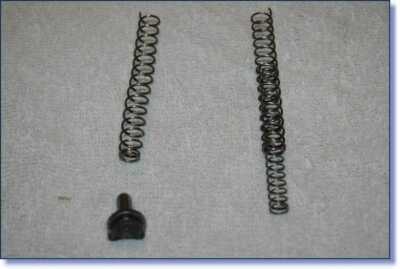 |
| The new, single coil recoil spring compared to the older Colt double spring model. Curiously, newer mini 1911’s have a double spring assembly such as the new Colt Defender models. |
So he there I was with my Colt – and I just couldn’t leave well enough alone. The first thing I did, as I do with any 1911, is fit it to my needs with a little customization. Before I knew it, I was doing a little shopping on Brownell’s website (www.brownells.com). First, I put a Wilson Combat Drop In Beavertail safety. I have found this tends to let the weapon sit lower in my hand. (Also lowering the chance for hammer bite.) I also put on a set of Hogue wraparound rubber grips and a new, modern single recoil spring. This combination dampened felt recoil significantly.
The ramp had some minor ridges from machine work, so a little work with some 600-grit wet/dry paper polished it up nicely. While not mirror smooth, it was free of any of the previous marks, and while it wasn’t quite shiny enough to shave by, it was perfect for reliability.
Off to the Range
This 20-plus year-old Colt easily qualified on my department’s off-duty qualification course. I have carried a number of 1911’s so the feel was nothing new. However, with the original double spring, the recoil was stouter than my Defender, which has an aluminum frame. Like I mentioned before, once the new recoil spring was in, the muzzle rise and recoil were downright pleasant.
Accuracy was better than my 3-inch model, but I won’t go and say it’s better due the gun itself or just the added sight radius. Regardless of the reason, off hand at seven yards I put one ragged hole in three shots, with a fourth flyer. The three were ¾ inch center to center, and the fourth opened it up to 1-½ inches. This is more than enough for combat accuracy.
The shorter barrel allowed for quick presentation from the holster, and pointed very well. The old-school Colt sights were easy to pick up, even if the white dots are a little faded now. This sight setup has worked for decades by now, and will perform either plinking or in combat.
How Does it Carry
While many people in the continually growing CCW market are looking to some of the newer wonder-1911’s with a lightweight aluminum frame, the Colt Officer’s is a strong contender. The truth is, a holster makes more difference to me than a few ounces, and is as important as the gun itself when considering something for CCW. Using the right holster can make all the difference in the world.
I had sent off one of my usual carry weapons for work at Unertl Ordnance for some new sights. I adopted the Officer’s ACP as a carry weapon during the interim. It carried easily in a Galco Silhouette holster, and was quite comfortable on my belt. I also purchased a Bianchi ankle holster for deeper concealment. The gun was on my ankle for 10-12 hours at a time and I hardly knew it was there. The Bianchi design took a little getting used to, but it turned out to be pretty comfortable. It is also one of the few designs that’s made specifically for the small 1911’s. With the renewed interest in these guns, I would suggest other holster makers take notice as well.
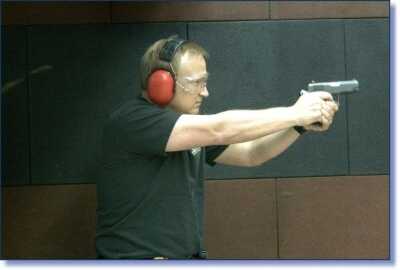 |
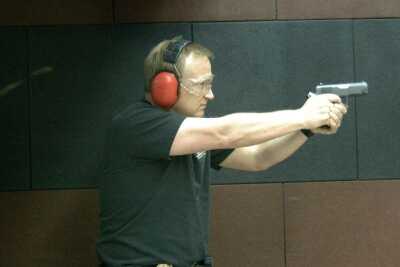 |
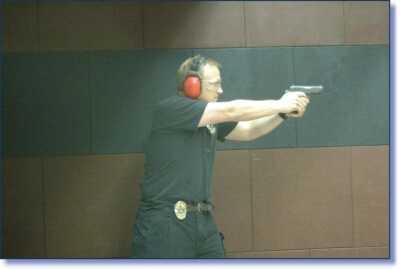 |
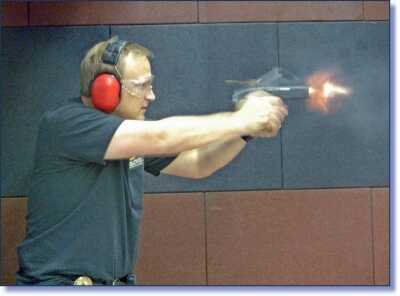 |
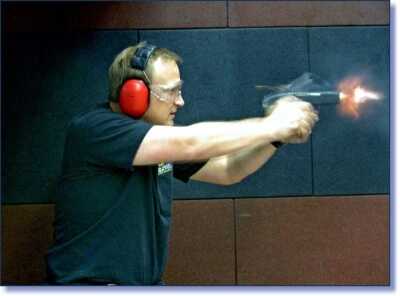 |
The added weight of the steel frame was no issue, and I would almost forget I had it on. It sits well on the hip, or the ankle. The shorter frame prints less under your shirt, and the shorter barrel is ideal for concealment.
Future Additions…
Of course, as with any 1911, it’s hard to just let it be. My future plans are to have the weapon refinished in a protective coat of some kind and add some night sights. Part of me hates to alter such a piece of history. But as with most of my guns, they are for carry – not just for nostalgia. Their goal is to save my butt when you have to be ready to do the unthinkable when forced to defend yourself. Carried guns need to be able to stand up to the elements, and sights need to be useable in limited light.
Colt has a history of making a pretty impressive weapon, and the Officer’s ACP was no exception. I hope they someday re-issue this fine pistol in another production run, and add some of the improvements like the ones that have gone into their XSE models. Even if they don’t re-release the Officer’s, there are still a quite a few out there to be found if you look. You may have to comb the web, but they are still available. While Colt has discontinued the Officer’s ACP in favor of the aluminum framed Defender, there is just something that seems more durable – or just nostalgic, about a steel gun. It’s just a plain classic.
Until next time..
– Brian

Nice article, am building an Officer from an 80%. Can you lead me to where the mainspring housing retaining pin location is? Thanks
Great writeup on a fine gun. I have a polished SS and after reading this, compared it to a Glock 26. The Officers is a tiny bit shorter in length. I would have lost that bet! The Glock grip is considerably shorter; but overall more difficult to conceal due to its “Brick” shape. I will have to try the one piece recoil spring – could use a little less recoil for sure.
I have a stainless steel verson enhanced. My first time out with it was amazing. I shot dead center with no adjustment to the sights at all. Perfectly indexed! No malfunctions with several makes of magazines including some military 60 era magazines.
I is all origional and I don’t plan on doing anything to it unless it needs it. It is my carry gun for off duty.
I love the feel of it. The sight radius and duck tail. It all works for me.
I also like the fact that it doesn’t have the forward grip cuts, ambidextrous safety and other junk you don’t need on a weapon. No mods needed.
Hello,
I own a Colt mkiv series 80 officer. I wanted to upgrade the beavertail but cannot find the part number on wilson combat site. They have them for the government model but i didnt think they were the same size.
Can you please tell me the wilson combat part number for the officers model series 80?
I have seen a skeletonized HAMMER AND TRIGGER, but cannot find a site that sells them and the IMSI flat recoil spring. Is there a one stop shop weboste where i can customize my officers model mkiv?
God bless america
I have owned three officers model Colts. My favorite is the Light Weight Officers which had some ‘OEM’ modifications done by Wilson. I carry it with just three rounds and have debated dropping this to two. This makes for a much more comfortable carry than a standard officers. I found them all to be accurate pieces. The second one I bought had been ported and it was surprisingly accurate. While I try to keep them stock, there is a clear benefit to make modifications to these.
I have all the parts for a SS officer’s model except the frame. Will these parts work with a commander frame?
My oldest son was given a Colt Mk IV Series 80 .380 pistol and it was rusted shut! (Damn shame, but) anyway he has gotten it unstuck and operating except he thinks the firing pin is broken! Where can I get a manuel on this great old Colt pistol and buy a new firing pin for it? I haven’t seen it yet but from looking at pictures of it on the web it looks like it is put together just like our old 1911 .45’s we had in the Marine Corps, the most simple and efficient handgun ever made. Any help will be appreciated. Thanks, and Semper Fi, Gene The series no. is RC58162 and has gold Colt medallion logos on the grips. Any help with this? Thanks
Great write up on one of my favorites. Thank you